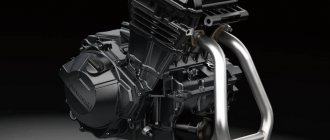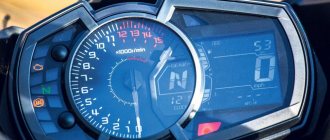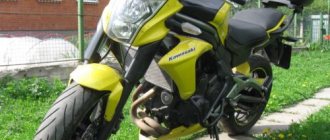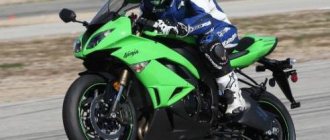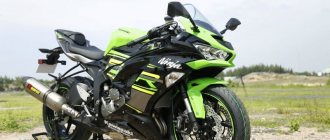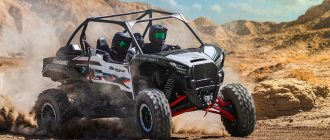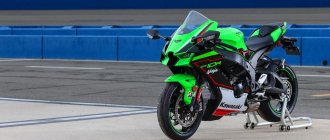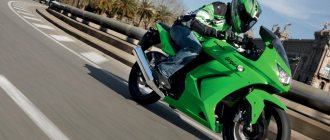RU-MOTO rating
- Reliability
- Chassis
- Appearance
- Comfort
- Ride quality
4.4
Verdict
The motorcycle is well suited for riding within the city. According to the owners' reviews, it is comfortable to drive the "ruff", the back does not get tired, the seat is not too soft and not hard. In my opinion, the design is a C plus.
Read other motorcycle reviews Review of Suzuki Boulevard M109R
Motorcycle Kawasaki ER-6N
The Kawasaki ER-6n abs motorcycle is designed and assembled in Japan. A street-class bike will be appreciated by professionals. It combines elegance and sportiness. The streamlined contours of the bike increase its aerodynamic characteristics, and the sharp edges and sections give it a unique and unique design.
The two-cylinder Kawasaki Ruff motorcycle with an engine capacity of 649 cm3 is equipped with a six-speed gearbox, and the transmission is ideally suited for city roads. A comfortable, low seat with fabric upholstery will bring real driving pleasure to its owner.
Specifications
The most important:
- power 72.1 hp;
- maximum speed 201 km/h;
- weight 206 kg;
- acceleration to 100 km/h in 3.7 s;
- fuel consumption from 3 to 4 liters.
| Engine | |
| Number of cycles | 4 |
| Number of cylinders | 2 |
| Number of valves per cylinder | 4 |
| Configuration | Row |
| Working volume | 649 cm³ |
| Bore and stroke | 83×60 mm |
| Maximum power | 72.1 hp at 8500 rpm |
| Maximum torque | 66 N•m at 7000 rpm |
| Intake type | Injector |
| Recommended fuel | AI-95 |
| Cooling system | Liquid |
| Starting system | Electric starter |
| Transmission | |
| Gearbox type | Mechanical |
| Number of gears | 6 |
| Clutch | Multi-disc, oil bath |
| main gear | Chain |
| Dimensions and weight | |
| Length | 2110 mm |
| Width | 770 mm |
| Height | 1180 mm |
| Seat height | 805 mm |
| Wheelbase | 1410 mm |
| Ground clearance | 130 mm |
| Curb weight | 204 kg |
| Fuel tank capacity | 16 l |
| Chassis and brakes | |
| Frame | Steel tubular |
| Suspension | |
| Front | Telescopic fork |
| Front suspension travel | 125 mm |
| Rear | Pendulum with monoshock absorber |
| Rear suspension travel | 130 mm |
| Brakes | |
| Ahead | Double disc hydraulic with 2 piston calipers |
| Diameter | 300 mm |
| Behind | Hydraulic disc with 1-piston caliper |
| Diameter | 220 mm |
| Tires | |
| Ahead | 120/70 ZR17 58W |
| Behind | 160/60 ZR17 69W |
| Production | |
| Country of Origin | Japan |
Engine
The motorcycle is equipped with an engine with a displacement of 649 cubic centimeters. The engine type is in-line, two-stroke and four-cylinder. The maximum speed that the motorcycle can reach is 205 kilometers per hour. This is a solid figure for a road bike.
The torque of this engine is 64 Newton meters at 7000 rpm. Its maximum power is 72.1 horsepower at 8500 rpm. These are serious characteristics for such a motorcycle, and perhaps the Kawasaki ER-6F may even surprise some.
Advantages and disadvantages
pros
- stylish design;
- high reliability (2-year warranty from the manufacturer without mileage restrictions); (moto.auto.ru/motorcycle/new/sale).
- convenient gearbox (it is impossible to mix up gears);
- reduced level of emissions (thanks to the honeycomb catalyst, maximum neutralization is achieved);
- good handling compared to other motorcycles of the same class, for example, the Yamaha XJ6;
- safe braking system (twin 300 mm discs at the front and single 200 mm discs at the rear, as well as the built-in ABS system allow you to control the bike in any bad weather).
Minuses
- front suspension too soft;
- controversial quality of welding and rigidity of the frame structure;
- vibrations when driving from 5 thousand revolutions;
- discomfort of driving outside the city due to the lack of massive fairings.
Advantages and disadvantages of the Kawasaki ER-6N motorcycle
How Kawasaki took over city streets
What should you offer customers to lure them away from competitors? That's right - a good product at a good price. Having bet on the Kawasaki EP6, the Japanese were right - the inexpensive, moderately powerful and generally attractive bike quickly won the audience award. What distinguishes it from most other 600 cc road cars is, first of all, the engine – an in-line “two” instead of the usual “four”. At the same time, the Kawasaki ER 6N has good technical characteristics, and the main advantage of its engine is that it does not need to be “twisted”. The engine, which is less boosted than the inline-four, feels very peppy at low and medium speeds, and accelerates the motorcycle very smoothly. The Kawasaki EP6N engine turned out to be so good that it subsequently, in a slightly modified form, served as the basis for the touring enduro Kawasaki Versys 650. At the same time, the hero of our article differs from the ER 6F model (aka Ninja 650R) mainly in the absence of a plastic body kit, representing a classic modern naked bike.
The suspension he got, of course, was simple - a 41-mm telescopic fork in front, a classic pendulum with preload adjustment in the rear. The brakes are also stellar - two 300mm discs with 2-piston calipers at the front and a 220mm disc with 1-piston caliper at the rear. The effectiveness of the braking system can be rated 4 points on a 5-point scale, but the situation is improved by the ABS system, which was offered as an additional option during the release years of the Kawasaki ER 6N.
Comparison with analogues
In comparison with the Honda NC700X (costs 50 thousand rubles less than the “ruff”) and Yamaha XJ6, the cost ranges from 7800 to 8500 dollars. The motorcycle is small in size, with a wider handlebar, which ensures easy handling. In terms of acceleration to hundreds, the Kawasaki Ruff is faster than the Yamaha XJ6 by 0.9 seconds and the engine has enough thrust for any gear and revolutions (up to 7000 per minute).
Competitor of the “ruff” Honda NC700X profile view. Photo mail.ru.
Video
- Brief review of the Kawasaki ER-6f.
- Review of the Kawasaki ER-6n motorcycle.
Kawasaki ER-6N
— perhaps one of the most popular mid-sized classic motorcycles. It is popular both among beginners who are just beginning their acquaintance with the world of two-wheeled horses, and among experienced motorcyclists who like the unpretentiousness of this motorcycle and its low price. And indeed, the ER-6N is inexpensive, even cheaper than its plastic-clad brother, the Kawasaki ER-6F, and in terms of maintenance and service it doesn’t really fit into your pocket.
Produced since 2006, this motorcycle is a very balanced unit in all respects. The engine is a liquid-cooled in-line twin capable of producing 72 hp. and 64 nm of torque. For beginners, this may even be too much, and a more experienced biker with such a “charge of vivacity” will not get bored. In addition, the Kawasaki ER-6N engine is tuned in such a way that its optimal speeds are low and medium, which makes travel during everyday trips around the city very dynamic and comfortable.
However, despite a certain budget, the Kawasaki ER-6N is able to please even the picky owner. The motorcycle accelerates from 0 to 100 km/h in less than four seconds, and this is largely due to the engine’s excellent pull from the very bottom. Thus, despite the truly flexible, friendly character and lack of “twitchiness,” novice motorcyclists should be careful with the ER-6N. Opening the throttle too sharply can lead to unpredictable consequences - it has plenty of power.
Separately, it is worth noting the excellent handling of the bike. Thanks to the relatively long wheelbase and low center of gravity, the Kawasaki ER-6N handles really well, and the brakes don’t let us down - two discs on the front wheel and one on the rear stop it more than effectively. The externally compact gas tank holds up to 16 liters of gasoline, which, with a consumption of within 5 liters, gives the ER-6N an excellent power reserve. however, in cities there are already enough gas stations, and the ER-6N is not very well suited for long journeys due to the complete lack of wind protection.
Produced since 2006, the motorcycle has been modernized several times. In 2008, he got different brakes and a front fork; in 2009, the entire exterior was heavily redesigned, a different radiator, a different pendulum were installed, and the steering wheel and engine mounts were equipped with silent blocks designed to reduce vibrations. Finally, in 2012, the Kawasaki ER-6N was updated once again - again it received a different appearance, a slightly higher seat and a slightly lower handlebar, thus bringing the riding position closer to a sportier one.
Of course, the 600cc classic motorcycle class is extremely competitive. Here are the Suzuki Gladius 650, and the Honda NC 700, which also has an automatic transmission, and the Chinese with their Stels Benelli 600... But it is the Kawasaki ER-6N that can be called the most popular among all its classmates. Perhaps its low price, overall balance, and excellent reliability played a role. Be that as it may, this is indeed a very successful model, equally well suited for both beginners and experienced motorcyclists.
Tuning features
Every owner wants his bike to have a unique styling. To achieve this result, tuning is used. It can be external, engine tuning and chassis. External work includes painting, replacing fairings, handles, stickers, and mirrors. It is done mainly for “show-off” or to give the motorcycle an aesthetic appearance. A motor conversion is an improvement in the power output of a bike by replacing some of the factory parts with others or eliminating them if necessary. When the chassis is replaced, the wheels, brake system, clutch, suspension, or, in other words, everything that can improve its technical capabilities are replaced.
Tuning the appearance of the Kawasaki ER-6N. Profile view.
Brief history of the model
- 2017 - start of production and sales of the model. First generation.
Model
: Kawasaki Ninja 650 + ABS (all regions).
Factory designation
: EX650JHF + EX650KHF.
- 2018 - no significant changes.
Model
: Kawasaki Ninja 650 + ABS (all regions).
Factory designation
: EX650JJF + EX650KJF.
- 2019 - no significant changes.
Model
: Kawasaki Ninja 650 + ABS (all regions).
Factory designation
: EX650JKF + EX650KKF.
- 2020 - restyling of the model. Second generation
.
Model
: Kawasaki Ninja 650 + ABS (all regions).
Factory designation
: EX650NLF + EX650MLF.
- 2021 - no significant changes.
Model
: Kawasaki Ninja 650 + ABS (all regions).
Factory designation
: EX650NMFNN + EX650MMFNN.
- 2022 - no significant changes.
Model
: Kawasaki Ninja 650 + ABS (all regions).
Factory designation
: EX650NNFNN + EX650MNFNN.
Owner reviews
Reviews of the Kawasaki ER-6N boil down to the following:
- control devices are located conveniently and do not require getting used to;
- the gearbox works smoothly, there are no problems finding neutral;
- the headlights are soft and pleasant;
- however, quite noticeable vibration at high speeds adds discomfort;
- For a person taller than 180 cm, there are some inconveniences associated with a low seat.
Screenshot of review No. 1
Read other motorcycle reviews of Racer Enduro RC150 GY
Screenshot of review No. 2
Advantages
Well-designed side wind protection allows you to feel comfortable at fairly high speeds.
The owners include:
- Inexpensive maintenance. “This is exactly the case when it’s better to pay but get quality.”
- Large selection of components.
- Maintainability. A minimum of electronics, simple parts, no “abstruse patented technologies.”
- Good spacing of mirrors.
- The low saddle simultaneously reduces external dimensions and allows you to ride comfortably (although not many people like the forward-leaning seat). And the fabric upholstery will not allow you to move out during acceleration/maneuvers.
The rear suspension of the motorcycle leaves much to be desired. If there are no problems with a light passenger, then with a larger load, the release is triggered on uneven surfaces.
